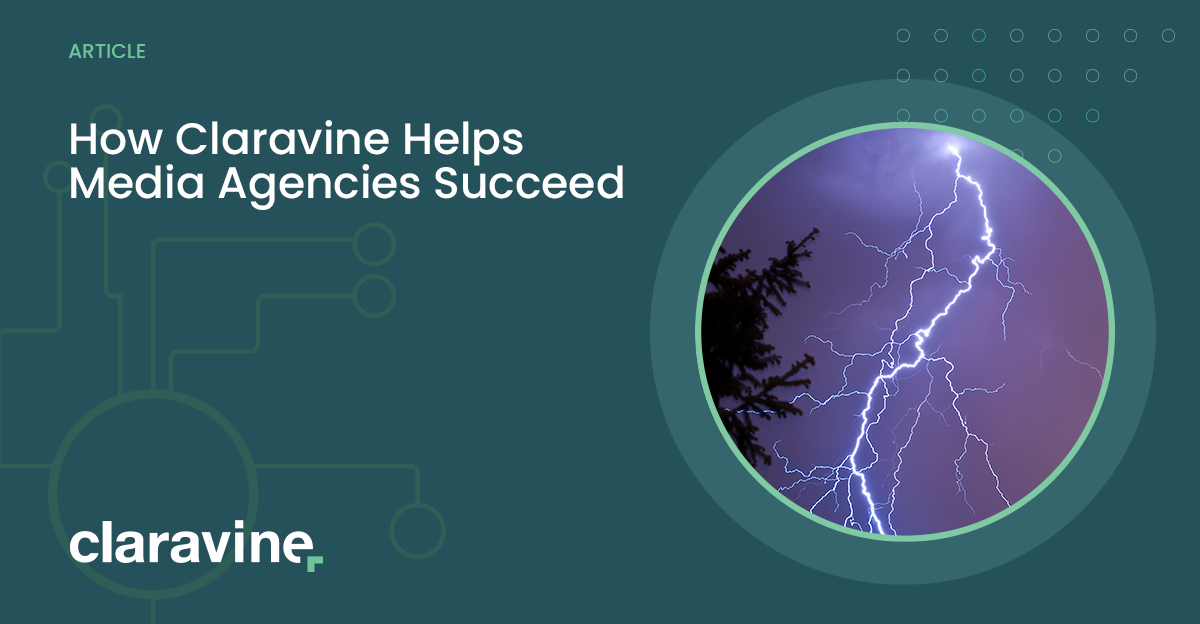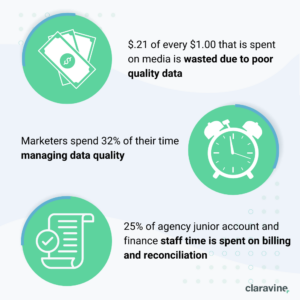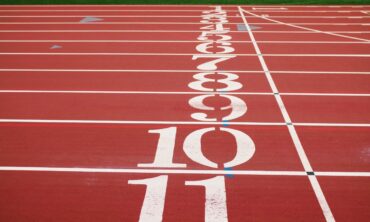How Claravine Supports Agency Success

Bad marketing data leads to wasted ad budgets, time, and can ultimately impact profitability. To mitigate these issues, its crucial for agencies to pinpoint the underlying causes.
If you’re working in adops or analytics at a media agency, the process below may sound familiar…
- A creative agency delivers the digital assets moments before the campaign is scheduled to launch.
- Assets are delivered to their respective agencies (programmatic, social, etc).
- Each agency uses a different naming convention template and spreadsheet macros to produce URLs with campaign tracking information.
- Additional requests pile in. Suddenly the search marketing team wants to track every keyword individually with a unique URL.
- You’re sorting through thousands and thousands of line items for the media campaign.
- The adops team QA’s the process to make sure the right creative assets are uploaded and assigned to their respective creative in each platform.
- Finally, the campaign goes live. The campaign agency manager takes a deep breath as they start spending the client’s money.
And then two weeks later…
- An agency analyst notices that a campaign might be over or under pacing and looks into it.
- They discover that a few of the line items and their respective naming conventions have the wrong creative and wrong click-through URLs assigned to them.
- They may go in and fix the issue… or they may not.
It’s a pain, but is Data Governance really something we should prioritize?
We estimate that at least 30% of adops and analytics time is spent chasing down and correcting mistakes that are the result of error-prone and manual data governance approaches.
In many cases, even if a mis-trafficking mistake is noticed, mistakes persist because it is too much trouble to try and unwind them in fast enough to make an impact, especially on shorter campaigns. This obviously corrupts the data that is used to optimize campaigns, but if nobody is looking closely, it is easily ignored.
The downstream effects caused by the errors multiply in significance and cost to the agency and to the brand.
- Creatives assets are uploaded to the wrong line items with incorrect landing page URLs or incorrect flight dates.
- Trying fix the known errors after the campaign means it will take weeks to produce basic campaign reporting.
- Campaign payment is a burden for junior analytics and finance staff that handle reporting and reconciliation.
As a result of these issues,
- $.21 of every $1.00 that is spent on media is wasted due to poor quality data
- Marketers spend 32% of their time managing data quality
- 25% of agency junior account and finance staff time is spent on billing and reconciliation

The list goes on. Almost every downstream operation is affected, and the entire agency-client experience turns into finger-pointing across departments. Is it any surprise that, after a year or two of this, the client may want to see if the grass is greener at the digital media agency across the street?
This is the dark underbelly of agency digital media operations.
The industry’s emphasis on campaign insights and optimization focuses too much on campaign outputs in reporting/business intelligence while overlooking the inputs. As a result, the outputs are contaminated and unreliable due to a lack of data governance at the input stage.
Even if this is done well by every agency in the mix in their own area of responsibility like search or social the process is not consistent between the search and social groups especially if they are in different agencies.
Isn’t this just something every agency has to deal with? What’s the solution?

A lack of governance during the input process adds operational drag to the digital media management process. The impact is that all downstream use cases of reporting, AI, automated optimization are likely an unrealizable pipe dream on the agency exec’s wish list, since the operational team may have the technical capability but not the data assets required to get there.
By focusing on the data governance and taxonomy management of the inputs, software from Claravine brings enterprise-grade, production level QA and management to the marketing data process. Campaigns run through Claravine templates are 100% reliable and consistent across channels. By focusing on the inputs, the team can eliminate almost all of the negative downstream effects.
With Claravine the agency receives the following benefits:
- Scale new lines of business to service clients by reducing operational drag across digital channels.
- Win back in-housed search and web analytics budgets through superior ops
- Avoid financially and reputationally costly and embarrassing trafficking errors through Claravine’s cloud-based dynamic controls.
- Unlock the full potential of services and tech by operating cleanly from the beginning and liberating the teams that are dependent on downstream data.
Bottom line: add operational confidence to the organization, deliver more for existing clients, win new clients, increase profit margins, make more money.
Claravine helps the agency increase revenue by enabling the agency to deliver client love and to expand its business.
Claravine does this by minimizing the operational friction that permeates the agency culture like a bad Social Media challenge. Claravine is the angel on your shoulder telling you it’s probably not a good idea to stack milk crates and walk over them, dance outside your car while it’s rolling down the street into traffic or worse.
The standardization of process and governance across Digital Marketing disciplines brings back the agency swagger of Mad Men days. It re-grounds the agency’s culture in the inherent confidence that comes from quality work delivered with purpose.
Explore how Saatchi & Saatchi partnered with Claravine to streamline their campaign data processes:


